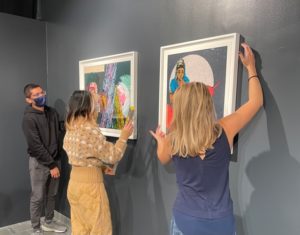Infinitude: a word that that captures the vast scale of the galaxy and the seemingly boundless reaches of technological advancement. Infinitude is also a term used by nineteenth-century American author Ralph Waldo Emerson to encompass his view of the limitless potential of the self-reliant individual, freed from the constraints of society.
Gallery 360’s new contemporary art exhibition, opening today, probes the possibilities and problematics of “infinitude,” presenting six visual artists whose visions are turned towards the future. How is the future being shaped? By – and for – whom?
As billionaires compete in a modern-day space race, this exhibition examines timely questions of privatization, justice, class, colonialism, and individualism. The artists featured – Larry Achiampong, Mónica Alcázar-Duarte, Josh Begley, Chitra Ganesh, Sofia Karim and Katie Paterson – are from across the US and UK, many debuting new work at Northeastern University especially for this show.

New Frontiers of Collaboration
Just as the artists explore the concept of “infinitude,” the exhibition itself traverses the boundaries of art and collaboration.
An international and interdisciplinary project, Infinitude not only brings together artists from across the US and UK, but also leaders across fields. Jointly created by collaborators in the College of Arts, Media and Design’s Center for the Arts (consulting curator Amy Halliday), the School of Law and College of Social Sciences and Humanities (Patricia J. Williams) and the University of the Arts London-based research collective Visible Justice (Max Houghton and David Birkin), this exhibition is a powerful example of the unique way that art can bridge disciplines to examine urgent contemporary issues through a fresh lens. The exhibition grew out of ongoing conversations, as Distinguished Professor of Law and Humanities Patricia Williams explains:

“Each of us had a slightly different take on humanity’s rather poetical yearnings for the immensity of space—whether aeronautical horizons, terrestrial landscapes, or the depths of the deep blue sea. We tussled with the degree to which that ancient sense of awe has been vexed by the infinitely expansive imaginaries of cyberspace,” says Williams. “The normative juridical constraints of the nation state are being rapidly displaced by technological reconfigurations of both private property and public geography. Fueled by powerfully transformative transhumanist ideologies, plans for planetary and oceanic colonization have expanded in tandem with military advances, creating new ways to dwell in, delineate and dominate the universe: whether on Mars, in Charter Cities or by Seasteading.”
From curriculum development, to hosting a colloquium, to establishing a Center for the Arts seed grant for related research – and now this exhibition – the partnership has proved fruitful:
“The richness of this collaboration, and the extraordinary opportunity of being in regular touch with everyone’s thought, is already leading to a wealth of future projects. It’s all been about thinking together, thinking across disciplines,” say David Birkin and Max Houghton of Visible Justice. “As Visible Justice, we are interested in the idea of the exhibition as a public forum, recognizing the power or potency of the image in knowledge creation… An exhibition is an excellent opportunity to bring in the layeredness and nuance that is so often missing in media discourse, for example in the work by Sofia Karim, which reaches towards an entirely different mode of freedom than that expressed by the space race.”
As a responsive contemporary art space, and a dynamic hub for research, teaching, and public engagement, Northeastern University’s Gallery 360 offers just such a forum.
The Art
Opening on October 21, Infinitude features both new and existing works by the participating artists.
“This exhibition brings together the thought of six visionaries from a cross-section of perspectives, each considering the social, legal, environmental and expressive complications posed by powerful new architectures of ownership, symbolic power, typological assortment and incursive surveillance,” explains Williams. “Given technologies that have come to regulate nearly every aspect of our material and digital lives, the work of these artists centers on mapping and retrieving governability from the frequently non-transparent realm of what has too often eluded collective address as “ungovernable.”
Alcázar-Duarte’s work, Ikamo Tlalli (“earthless” in Nahuatl) was created especially for Infinitude. Since 2014, Alcázar-Duarte has been making work on space exploration, environmental justice, and the way in which colonizing Mars has increasingly captured the popular imagination (with models for its terraforming based on the South Atlantic Island of Ascension, to which she regularly alludes). Alcázar-Duarte is interested in what there is to learn from ways of life that have been downplayed throughout history in order to further the project of western progress: her three-channel video installation offers other ways of seeing, doing, discovering, and knowing.
“I hope that the next time viewers encounter news, film, song or adverts on space exploration they think of the wonderful planet that we have and how it took millions of years for it to become a perfectly balanced environment for life,” says Alcázar-Duarte. “I want people to think how fragile this is, and how imperative it is that we preserve and take care of it.”

Karim’s series Lita’s House, never before publicly exhibited, represents an attempt to visually express her theories on space as a site for struggle or resistance and a way to explore human loss. A professional architect, Karim has continued to develop and push her discipline’s tools and values towards the articulation of “An Architecture of Disappearance”, catalyzed by her uncle’s incarceration by the authoritarian regime in Bangladesh. Karim is an activist and human rights advocate for those who have been jailed or disappeared for pursuing freedom of expression, a freedom palpably yearned for in her cosmic geographies:
“To a large extent, the drawings are me plunging into uncharted territory in my own mind,” Karim explains. “I am grateful to be able to exhibit work at this stage of development: unresolved and restless. As I struggle to fathom the forces of fascism and authoritarianism that I contend with, I am less interested in drawings which give answers and more interested in drawings which search.”
Explore
“Art imagines otherwise, and engages in powerful ways with the emotional register. It can help people to engage with their background thoughts that they haven’t yet been able to articulate,” say David Birkin and Max Houghton of Visible Justice. “Certainly our own engagement with these issues has been expanded and challenged in all sorts of directions through our work with each artist, and with each other. This kind of generosity – sharing the space and time to co-create a project like this – is truly a gift. We’re excited to see how the exhibition will offer provocations to the campus and broader community, and provide a scaffold for teaching and learning around issues at the intersection of art, technology, identity, law and governance.”

Head over to Gallery 360 from October 21, 2021 through January 22, 2022 to think, engage, and imagine the future in new ways through Infinitude – and join us for an opening reception on Tuesday, October 26 (RSVP here). Stay tuned for upcoming programs with the artists and curators, and contact Center for the Arts Director Juliana Barton ([email protected]) to organize a class visit or tour.
The gallery is located on the first floor of the Curry Student Center and can also be entered through Ell Hall, 346 Huntington Avenue.


